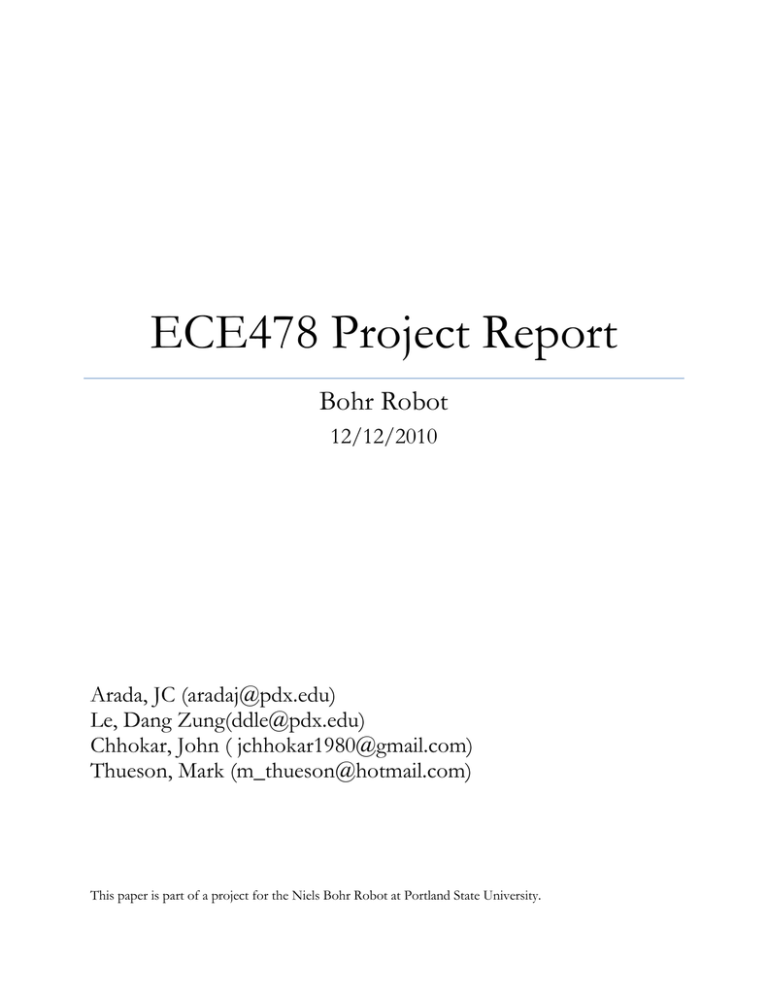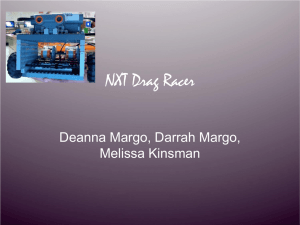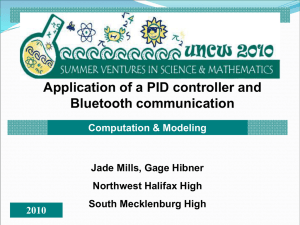
ECE478 Project Report
Bohr Robot
12/12/2010
Arada, JC (aradaj@pdx.edu)
Le, Dang Zung(ddle@pdx.edu)
Chhokar, John ( jchhokar1980@gmail.com)
Thueson, Mark (m_thueson@hotmail.com)
This paper is part of a project for the Niels Bohr Robot at Portland State University.
Contents
Problem Statement ............................................................................................................................3
The Hardware ...................................................................................................................................3
Wiring diagram........................................................................................................................................... 5
Speech Recognition ..........................................................................................................................6
The Software.............................................................................................................................................. 6
Speech API ................................................................................................................................................ 7
Developing Bluetooth application in robot C.....................................................................................9
Neils Bohr Arm Wheel Bluetooth Interface Spec ..................................................................................... 10
Implement Bluetooth in Visual Basic ....................................................................................................... 12
Blue Tooth Protocol File Calls in VB ....................................................................................................... 14
Blue Tooth Protocol Mailbox in VB......................................................................................................... 15
Visual Show Automation ................................................................................................................. 16
You Tube Example .................................................................................................................................. 17
Bohr GUI ........................................................................................................................................ 17
SVN ................................................................................................................................................ 18
Future Plans ECE479 ...................................................................................................................... 19
2
Bohr Robot Project
Problem Statement
To bring up the Bohr Robot from last year’s working condition and add speech recognition and
vision. We are missing a few key components from last year’s robot configuration: (laptop,
software, 12volt battery for motors). Our goal this term is to not only bring the robot up, but to
implement speech recognition and vision. In addition, we wanted to add Bluetooth to the robot.
Below is the original configuration of the robot from last year’s group.
Figure 1: Original Robot Configuration
...will be modified as one of the following:
The Hardware
Our group purchased the following hardware below.
Figure 2: Proposed Re-Design I
3
Bohr Robot Project
Figure 3: Proposed Re-Design II
To implement Bluetooth communication we purchased the following Bluetooth adapter for my
computer. This Bluetooth adapter is made by IOGEAR and has a maximum wireless range of
30feet.
Figure 4: Bluetooth Adapter
To improve speech recognition I bought a pair of high quality noise cancelling headphones from
Costco for $89.00. I realized that this was a crucial part for the project and this headset gives me the
ability to communicate through USB wirelessly with 3 feet of range.
Figure 5: High Quality Headset
We need a 12volt battery to power the motors on the base. The battery used by last year’s group is
missing. The 12 volt battery shown below was purchased for $30.99.
Figure 6: 12 Volt DC Battery
Lastly, we purchased another NXT Brick for testing purposes. We did not want to erase the
functions on the NXT written from the previous group. In order to continue to add to the software
files on the NXT we would have to download new firmware and we might erase their code. The
NXT brick is $135.00.
Figure 7: NXT BRICK
4
Bohr Robot Project
Wiring diagram
Figure 8: Wiring Diagram
5
Bohr Robot Project
Speech Recognition
Speech recognition is a complicated task because there are large sources of variability that are
associated with voice commands. One type of variability is found in a person’s voice. Acoustic
variability’s in ones voice can change the way the computer interprets phonemes. Phonemes are the
smallest units of sound and represent 500,000 words in the English language. When the user speaks
into the microphone, the user’s voice is converted into digital bytes of information which are
comprised of phonemes. The phonemes are then compared to a large library, and when a match
occurs the word is then given back to the user. The delivery of speech into the microphone is very
critical for this reason.
Another variability associated with voice commands is the user’s environment. External noise
associated to an environment can introduce all sorts of problems for the user. For example, a
speech program can be fully functional in a conference room where there is no noise, but can be
fully not functional when demonstrated in front of a room of noisy kids. For this reason, it’s very
important to have a high quality noise cancelling microphone.
Next, it’s important that a speech recognition program is tested in all sorts of environments. This is
another crucial step for the reasons stated in the previous paragraph. You can record the accuracy
of each command in each environment and predict how successful your program will work when it
is demonstrated.
Lastly, I will take two approaches to speak commands to the Bohr Robot. The first approach is to
communicate to the Bohr Robot over a serial wired cable and give the robot commands over a
wireless noise cancelling headset. Secondly, I would like to add Bluetooth to this robot and control
the robot by first giving it a command into the headset and then transmitting that command over
Bluetooth.
The Software
I am using Microsoft Visual Basic 2008 express edition. In order to include speech recognition into
your project you have to include references to the Microsoft Speech Object Library (COM) and
System.Speech (.Net). Since my computer is running Windows XP I had to download Microsoft’s
Software Development Kit 5.1(SDK 5.1) from Microsoft’s website. Links to download the required
software are provided below. All the software I downloaded was free.
Microsoft Software Development Kit 5.1
http://www.microsoft.com/downloads/en/details.aspx?FamilyID=5e86ec97-40a7-453f-b0ee6583171b4530&displaylang=en
Microsoft Visual Basic 2008 Express Edition
http://www.microsoft.com/express/Downloads/
6
Bohr Robot Project
Speech API
After two weeks of researching speech recognition I implemented a speech recognition algorithm in
software. Using Microsoft’s Speech Application Programming Interface (SAPI) a basic algorithm
was developed.
Start
Load Grammar
Libraries
Wait for speech detection.
Move to next state when a word
is spoken
Hypothesis
Move to next state when word
is hypothetically found
Display Text
Figure 9: Speech Algorithm
When the program begins, the program waits for speech detection. When a word is spoken into the
microphone, the word is broken into phonemes and then goes through Statistical Modeling to try
and find the word spoken. An example of modeling used in software is called the Markov Model.
An example of how a computer would interpret the word tomato is shown below. The word
tomato is broken up into several phoneme’s (T, ow, m, aa, t, ow). If you follow the phoneme
through the model below you will see that tomato can be pronounced two different ways but at the
last branch of the model there is a 90% chance that the word is tomato. That is the word that is
then selected. This type of modeling enables a much quicker type of speech recognition when
compared to a brute forced method.
Figure 10: Markov Models
7
Bohr Robot Project
There is one significant drawback to this model. Since this method try’s to match the word spoken
into the microphone to several words which may sound the same in the English language the results
are not optimal and often times return the wrong word. For this reason I must look at creating my
own language library instead of using Microsoft’s library.
One way to improve the speech recognition on a system is to take the speech recognition training
on your laptop. The following training is available in your control panel in the speech icon. The
more training you take the more accurate your speech recognition becomes.
Figure 11: Speech Training
Speech Demo to Class
One possible approach to speech recognition was presented to the class. This demonstrated the
background to speech recognition and how you can use voice commands to call functions. The
demonstration also showed how difficult speech recognition is. To improve speech recognition we
ordered a headset and implemented a custom grammar library using XML. We need to shoot for
95% accuracy of speech recognition.
To improve the speech recognition interface a custom grammar library was created instead of using
Microsoft’s grammar library. My initial thinking is that this would improve the program significantly
because it would limit the amount of words the engine had to find. I had to learn XML syntax to
create my own grammar library. After reviewing examples on XML I was able to successfully
implement my own grammar library. Microsoft’s SDK5.1 comes with a grammar library compiler
test environment. Here you can write your grammar libraries, compile and run them. If your voice
8
Bohr Robot Project
commands are recognized here then you can conclude that the voice commands will be recognized
in your program. An example of the grammar compiler is shown below.
Figure 12: XML Grammar Library
Developing Bluetooth application in robot C
Send/Receive Messages from NXT brick – this part taken from RobotC manual, for more
information see:
http://www.robotc.net/support/nxt/MindstormsWebHelp/index.htm#page=Bluetooth/sendingm
essages/Sending%20Messages%20via%20Bluetooth.htm
The NXT firmware automatically receives messages and adds them to a queue of incoming
messages. The application program takes the messages from this queue and processes them one at a
time. The variables message and messageParm contain the contents of the current message being
processed. The function ClearMessage discards the current message and sets up to process the next
message.
Example can be found in 'BtBasicMsg.c'
Other simple methods:
cCmdMessageGetSize get the size of the first message in a mailbox containing a queue of received
messages. cCmdMessageRead removes the first message from a mailbox queue and copies it to a user
buffer. Implementation requires checking for messages periodically and read any incoming messages
using cCmdMessageRead. Then interpretate this message and translate it into instructions.
Example can be found in ‘NXT BT Messaging No Error Checking.c'
For Pc-side code, see implementation below in Visual Basic for details.
9
Bohr Robot Project
Neils Bohr Arm Wheel Bluetooth Interface Spec
Both Arm and Wheels are completely controlled by the NXT block.
Interfacing with the NXT requires 2 Bytes (Four HEX digits) sent to the NXT
The first byte selects the motor
The second byte determines the values passed to the motor
The first Byte:
Decimal Hex
1
01
2
02
3
03
4
04
5
05
6
06
7
07
10
Function
Shoulder
Arm
Elbow
Wrist_ud
Wrist_lr
Hand
Left Wheel
Bohr Robot Project
8
9
10
11
12
13
14
15
16-255
08
09
0A
0B
0C
0D
0E
0F
Right Wheel
Forward
Reverse
Left
Right
RESERVED
RESERVED
RESERVED
10-FF RESERVED
The second byte is a Signed binary with values given in percentages
• MSB (bit 7) determines forward or reverse
◦ 0 is forward
◦ 1 goes in reverse direction
• Valid values are 0 to 100 on bits 6 to 0
Servo expectations:
Shoulder – Positive is right, Negative is left
Wrist_ud – Postitive is up, Negative is down
wrist_lr – Positive is right, Negative is left
Hand – Positive is open, Negative is close
Servo transition expectations:
Shoulder – 2 seconds
Wrist_ud – 1 seconds
wrist_lr – 1 seconds
Example code:
// check size of message in mail box
nSizeOfMessage = cCmdMessageGetSize(0);
// read bluetooth mailbox and put into receive-buffer
nBTCmdRdErrorStatus = cCmdMessageRead(nRcvBuffer, nSizeOfMessage, 0); // inmail 0
ClearMessage();
int temp;
// decode Bluetooth commands and execute
switch(nRcvBuffer[0]) // decode the first byte
{
case 0x09:
nxtDisplayTextLine(3,"forward...");
temp = nRcvBuffer[1]; // decode the second byte
forward(temp); // forward at power level 25
11
Bohr Robot Project
// send response to PC if need
cCmdMessageWriteToBluetooth(nXmitBuffer, kMaxSizeOfMessage, 1);// outmail 1
break;
}
Direct command
The NXT supports direct commands to directly instruct the brick over Bluetooth such as start and
stop a program loaded on NXT brick. This provides a simple way to control the brick from device
other than NXT (PC/handheld...). See the implementation below in Visual Basic for details.
Also see Bluetooth development kit 'Direct command' for more information:
http://mindstorms.lego.com/en-us/support/files/default.aspx
Note: RobotC does not support sending direct commands (so that one NXT brick can control other
NXT).
Implement Bluetooth in Visual Basic
We thought we could communicate to the Robot using our Bluetooth adaptor. The thinking was
that we could give the robot simple commands such as forward, reverse, right and left using the
headset and that command will be sent via Bluetooth. The previous group had implemented wireless
communication using a PSP controller. We wanted to use Bluetooth because it gives you a chance to
learn the Bluetooth protocol for communicating between the NXT controller and your laptop. In
addition, we have plans to control the laptop remotely and implement vision.
Bluetooth connection was successfully established between my laptop and the NXT brick. To learn
the protocol for Bluetooth and for calling sound files and software files, you have to reference Lego
Mindstorms NXT direct commands found in Appendix 2. The link for the document is shown
below.
http://code.google.com/p/smart-robot/downloads/detail?name=Appendix%202LEGO%20MINDSTORMS%20NXT%20Direct%20commands.pdf
We were able call sound files and software files on the NXT brick. We implemented the following
functions and drove the robot around the engineering lab using Bluetooth: forward, reverse left,
right and stop. Next steps are to use speech recognition to drive the robot. The Bluetooth protocol
the robot uses is shown below.
In order to call software files, or sound files, it’s important to really understand the protocol
architecture. To call a software file, you have to follow the protocol shown below under the Start
Program. I will cover an example for calling a left function on the NXT. The left program would
be already programmed into the NXT to turn the robot left. To call the left program in the NXT
you have to call left.rxe.
12
Bohr Robot Project
Figure 13: Byte Protocol
http://code.google.com/p/smart-robot/downloads/detail?name=Appendix%202LEGO%20MINDSTORMS%20NXT%20Direct%20commands.pdf
13
Bohr Robot Project
Blue Tooth Protocol File Calls in VB
Byte 0: How many bytes total in your message. Don’t count bytes 0 and 1.
Byte 1: Always send 0x00 for this byte.
Byte 2: You have two options here. If you send 0x00 then the NXT will send you a return
message. If you send 0x80 then no return message is sent. For most of the programs
that I wrote I left this byte programmed with 0x00.
Byte 3: This is the command Byte. Sending the byte 0x00 tells the NXT that you are going to
call a function.
Byte 4 - 21: In these bytes you send the ASCII equivalents of your file name. For example,
byte 4 would be coded with the ASCII equivalent of the first letter in your software file
name. In this example we are calling the software file right so ASCII (“l”) is sent.
Byte 5: Here you would send the ASCII value for “e”.
Byte 6: Send ASCII value of “f”
Byte 7: Send ASCII value of “t”
Byte 8: Send ASCII value of “.”
Byte 9: Send ASCII value of “r”
Byte 10: Send ASCII value of “x”
Byte 11: Send ASCII value of “e”
Byte 12: Send null terminator character “0” to end string. This is important!
An example of calling the left program from the NXT is shown below. You can call all of your
software files on the NXT by modifying the program code below to match your own software files
in visual basic.
'*********************************************************************
'* This functions calles the left software file on the NXT
'*********************************************************************
Dim byteOut(13) As Byte
byteOut(0) = &HB '11 bytes in output message
byteOut(1) = &H0 'should be 0 for NXT
byteOut(2) = &H80 '&H0 = reply expected &H80 = no reply expected
byteOut(3) = &H0 'Command
byteOut(4) = Asc("l") 'l character
byteOut(5) = Asc("e") 'e character
byteOut(6) = Asc("f") 'f character
byteOut(7) = Asc("t") 't character
byteOut(8) = Asc(".") '. character
byteOut(9) = Asc("r") 'r character
byteOut(10) = Asc("x") 'x character
byteOut(11) = Asc("e") 'e character
byteOut(12) = &H0
SerialPort1.Write(byteOut, 0, 13)
14
Bohr Robot Project
Blue Tooth Protocol Mailbox in VB
In the end we implemented a far better method to control the robot using Bluetooth. The technique
discussed earlier was still beneficial because it allowed us to run our final program on the NXT.
However, for each robot function such as (forward, reverse, left, right, arm up, etc...) we sent values
to the NXT mailbox. These values were then manipulated by the program running on the NXT and
that function was performed. The commands below are all implemented and fully functional.
Wrist Up
Wrist Down
Elbow Up
Elbow Down
Hand Open
Hand Close
Arm Left
Arm Right
Forward
Reverse
Right
Left
Stop
Motor Power Up
Motor Power Down
Shake Hand Routine
Below is an example of the hand open function.
'**********************************************************************
'* Hand Open Function. This function opens the hand when it is called.
'***********************************************************************
Dim byteOut(9) As Byte
Try
byteOut(0) = &H7 '7 bytes in output message
byteOut(1) = &H0 'should be 0 for NXT
byteOut(2) = &H80 '&H0 = reply expected &H80 = no reply expected
byteOut(3) = &H9 'Command
byteOut(4) = &H0 'inbox 0
byteOut(5) = &H3 'message length 2 + 1 null
byteOut(6) = &H6 'protocal first byte
byteOut(7) = &H8A 'How far to move right
byteOut(8) = &H0 'null terminate
SerialPort1.Write(byteOut, 0, 9)
Catch ex As Exception
MsgBox(ex.ToString)
End Try
15
Bohr Robot Project
Visual Show Automation
Visual Show Automation (VSA), is a software GUI created by Brookshire Software. It allows one to
control servos and automation using drag and drop techniques. The software was already purchased
by the previous group and we were able to obtain a soft copy of the software from the president of
the robotics society. The image below shows an example of the VSA screen. At the bottom of the
screen a wav file is shown. This file can be imported by selecting tools -> load audio file from the
menu. Before an animation is created, you have to define the servo definitions.
Servo controls
Servo Definitions
Wav File
Figure 14: Visual Show Automation
The servo definitions are setup in the tools -> settings -> device settings. This is the first step when
defining servo name as it allows you to setup minimum and maximum values. Below are the current
settings of the servos in the Bohr robot. After the servos are defined, you can drag bars onto the
screen. The length of the bars represent the time an animation will run. If you double click a bar
you can edit the servo beginning and end positions. For example, to rotate the head from left to
right, drag a bar onto the rotate head line. Double click the bar and edit the begin and end
positions. The starting position for the robot head is 156 (robot straight), to move the head to the
right edit the end value to be 45. Then when the animation plays and the timeline runs over the bar
that you just created, the robot head will move from the straight position and end in the right
position.
Figure 15: Visual Show Device Settings
16
Bohr Robot Project
You Tube Example
To demonstrate VSA, we choreographed a small skit and posted the video on You Tube. You can
view the video by typing in Bohr robot in the search file or view it by clicking on the link below.
http://www.youtube.com/watch?v=fRFuN9EYGwg
Figure 16: You Tube Bohr Robot
Bohr GUI
The Bohr robot was controlled using a GUI created in Visual Basic. The GUI allows the user to
implement all of the functions discussed in this paper which include the speech recognition system,
Bluetooth connection for file and mailbox calls on the NXT and all robot functions.
Figure 17: Bohr Robot GUI
17
Bohr Robot Project
SVN
All code for the Neils Bohr Robot can be found on the Open Source Repository of google.com
http://ece478robot.googlecode.com/svn/trunk/
18
Bohr Robot Project
Future Plans ECE479
The previous group controlled the robot using a wireless PS2 controller. We’ve been
working on voice and vision control as well as smoothing out some of the basic motions. Like
many other groups, in the future we would hope to make the robot more autonomous in nature
with the ability to free roam. In order to do so we need to implement two key components.
First, more sensors would need to be added, giving the robot the ability to perform object
avoidance. This would most likely be achieved by the use of sonar. This would also facilitate a need
to stop using RobotC and switch to something like NXT++ which we have already begun.
Depending on the number of sensors NXT++ makes it easier to integrate them all together.
Secondly an algorithm for mapping would need to be added, preventing the robot from
wandering around aimlessly. It would also start a foundation for any control algorithms, such as A*
or genetic algorithms, that can be implemented in order to reach a goal. In the end it would make
the robot much more interesting and fun to interact with.
19
Bohr Robot Project






